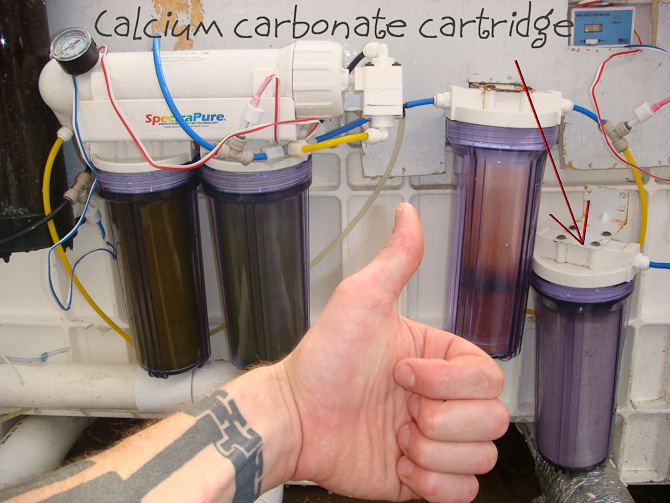I hope to spawn the acceptance of the idea that R/O units should have one more filtration module standard. What would be in this new canister? Aragonite. CaC03. Calcium carbonate. Yup, the reef aquarist’s best friend. Basically coral skeleton (there are also some oceanic processes that percipate aragonite straight from seawater.) This stuff dissolves in water below a pH of 8.2 which comes in very handy for our purposes of maintaining proper levels of essential elements in solution in our aquariums. Follow the link to continue reading on the Calcium Carbonate Cartridge and how you can easily make your top-off water work for you.
A calcium reactor uses carbon dioxide that dissolves in the water, that creates carbonic acid that lowers the pH, and thus dissolves the aragonite. So I was thinking that if the aragonite will dissolve with a pH lower than 8.2, then newly made R/O DI water should have a pH of 7.0, dissolving the aragonite, and thus supplementing the fresh water with carbonate ,calcium, magnesium, strontium, and all the other iums that was incorporated into the aragonite, the very same elements that your growing coral will re-use to make their skeleton, and in the same proportions (corals also lay down other elements within the calcium carbonate matrix of their skeleton).
Water leaving the canister should have a higher pH, preventing you from adding acidic (saltwater speaking) water directly to your aquarium. Some people use kalkwasser with their top off water, and this is a great way to increase pH, and calcium, but it can be dangerous if overdosed. With an aragonite canister there is no potential to fry your coral with alkalinity. In fact that comes out at a perfect 8.2. When tested on a TDS meter water leaving the R/O is reads 8-15ppm, after the De-ionizer 0-1ppm. Then after the aragonite canister, 25-50ppm. So we strip out all the bad stuff, then add some of what we want, all without mixing and measuring and such.
To create my pH-adjusting, calcium-adding canister I simply took a DI cartridge that was spent, emptied out the resin and replaced it with aragonite sand. I am currently using a sand grade a step or two above oolitic sand. I worry about impaction and dead spots if the grains are too small. So far mine have been functioning for months with maintenance. I can see that some of the sand has dissolved and in few months I will top off the canister with new sand.
Creating the proper balance of elements in our reef tanks are important to ensure the health of the inhabitants. Any help we can get in achieving these parameters makes our job of providing proper conditions that much easier. There are a lot of little tricks we can do, that when added up will give us more successful reefing experience.
Justin Credabel
Director of Aquaculture
Underwater World Enterprises




